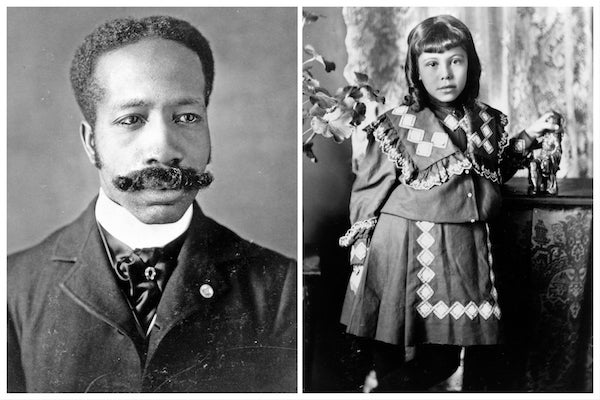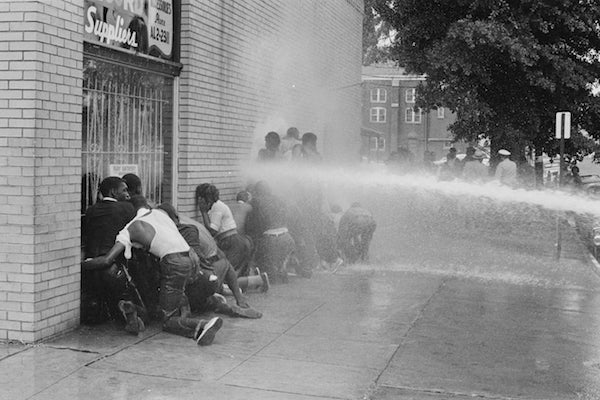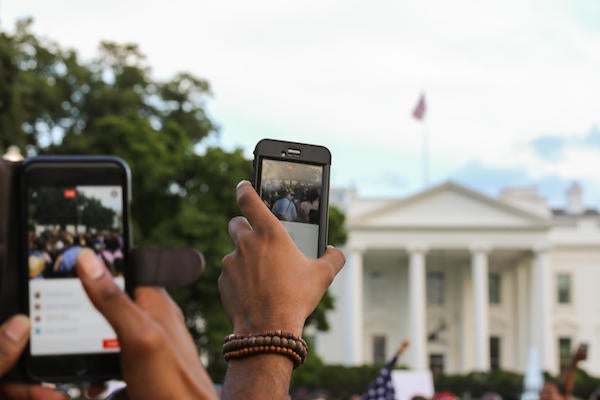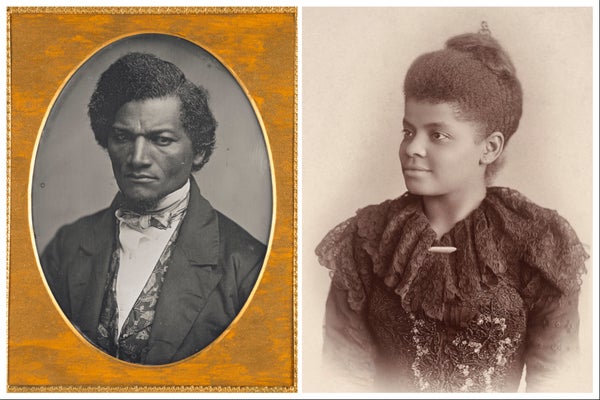In the 19th century, the most photographed man in the world wasn’t Walt Whitman or Ulysses S. Grant or even Abraham Lincoln. It was Frederick Douglass. The famous orator and abolitionist was known for using his eloquent voice to impart the horrors of slavery, which he had experienced firsthand. He traveled all over the country, speaking to large crowds and making arguments to end the enslavement of Black people. On the days when there were no scheduled lectures, he would visit a daguerreotype studio to have his picture taken. He enlisted these images as another thrust of his campaign, offering the public a positive view of a Black person to oppose the negative caricatures that were commonplace in newspapers. His handsome portrait was a weapon against these malicious images, because his photographs were sold by, and distributed from, the studios he visited. With them, picture by picture, he slowly changed the public’s perception of an African-American. Frederick Douglass knew back in the 19th century that Black images mattered. 在19世纪,世界上被拍摄次数最多的人不是沃尔特·惠特曼、尤利西斯·S·格兰特,甚至不是亚伯拉罕·林肯。而是弗雷德里克·道格拉斯。这位著名的演说家和废奴主义者以其雄辩的口才来传达他亲身经历过的奴隶制的恐怖而闻名。 他走遍全国,向大批人群发表演讲,并提出结束对黑人奴役的论点。在没有预定讲座的日子里,他会拜访银版照相馆拍摄照片。他利用这些图像作为他运动的又一次推动,向公众展示黑人的正面形象,以对抗报纸上常见的负面漫画形象。他英俊的肖像成为了对抗这些恶意形象的武器,因为他的照片是由他访问的照相馆出售和分发的。凭借这些照片,一张又一张,他慢慢地改变了公众对非裔美国人的看法。弗雷德里克·道格拉斯在19世纪就知道,相片中的黑人形象至关重要。
When Douglass had his pictures taken, rendering an image of a person was a democratic expression. For a small sum, the kitchen chemistry to sensitize a glass plate made it easy for anyone to have his or her image captured. Doing so became even easier as photography was adopted as anAmerican pastime, and camera manufacturers not only produced film, but processed it. Taking pictures became a big business. And W.E.B. DuBois, an African-American scholar born about 50 years after Douglass, also had great hopes that it would serve the cause of racial justice. DuBois knew the power of displaying Black images to sway the American consciousness. And he used pictures to showcase his race’s achievements with material that included portraits of educated Black individuals, images he showed in his Exhibit of American Negroes at the 1900 World’s Fair in Paris. 当道格拉斯拍摄照片时,为一个人渲染图像是一种民主的表达。只需少量资金,对玻璃板进行感光处理的简易化学方法使任何人都可以轻松捕捉自己的图像。随着摄影被采纳为美国人的消遣方式,这样做变得更加容易,相机制造商不仅生产胶卷,还冲洗胶卷。拍照成了一门大生意。W.E.B. 杜波依斯,一位在道格拉斯出生约50年后出生的非裔美国学者,也对摄影寄予厚望,希望它能为种族正义事业服务。杜波依斯深知展示黑人形象以影响美国意识的力量。他利用照片展示他种族的成就,其材料包括受过教育的黑人的肖像,这些图像他在1900年巴黎世界博览会上的“美国黑人展览”中展出。

African-American man (left). African-American girl standing next to table (right). Both images are from Types of American Negroes, compiled and prepared by W.E.B. DuBois. Credit: Getty Images (man); Getty Images (girl) 非裔美国男子(左)。非裔美国女孩站在桌子旁(右)。两张图片均来自 W.E.B. 杜波依斯汇编和准备的《美国黑人类型》。图片来源:Getty Images (男子); Getty Images (女孩)
On supporting science journalism 支持科学新闻报道
If you're enjoying this article, consider supporting our award-winning journalism by 如果您喜欢这篇文章,请考虑通过以下方式支持我们屡获殊荣的新闻报道 subscribing. By purchasing a subscription you are helping to ensure the future of impactful stories about the discoveries and ideas shaping our world today. 订阅。通过购买订阅,您将帮助确保未来能够继续讲述关于塑造我们当今世界的发现和想法的具有影响力的故事。
But unlike Douglass, DuBois grew leery of photography. Although it was a powerful way to push back against the stereotypes, this tool was starting to work against him. DuBois noticed that “the average white photographer does not know how to deal with colored skins,” he said. And the resulting pictures of Black people were often a “horrible botch.” 但与道格拉斯不同,杜波依斯开始对摄影持怀疑态度。尽管摄影是反击刻板印象的有力工具,但这种工具开始对他不利。杜波依斯注意到,“普通白人摄影师不知道如何处理有色人种的皮肤,”他说。结果,黑人的照片往往是“糟糕的拙劣之作”。
In 1915, as DuBois struggled with images of Black people, photography—and portrayals of African-Americans in particular—took a hideous turn. That year D. W. Griffithreleased his film The Birth of a Nation. This movie fabricated a false narrative of the Civil War and offered a redemptive account of the acts of the Ku Klux Klan: Griffith depicted the white supremacist secret society saving the nation from lecherous Black people (who were actually white actors in blackface). His film became the most loved movie in the nation. It was even watched in the White House by its fan in chief, President Woodrow Wilson. Griffith was a masterful moviemaker who pioneered the close-up, scenic long shot, and the crosscut. And he created a film that further contaminated the country. Griffith, like DuBois and Douglass, knew the power of pictures. 1915年,当杜波依斯仍在为黑人形象而苦恼时,摄影——尤其是对非裔美国人的描绘——发生了可怕的转变。那一年,D. W. 格里菲斯发行了他的电影《一个国家的诞生》。这部电影捏造了关于内战的虚假叙事,并对三K党(Ku Klux Klan)的行为进行了救赎性的描述:格里菲斯将这个白人至上主义秘密社团描绘成将国家从好色的黑人(实际上是涂黑脸的白人演员)手中拯救出来的英雄。他的电影成为全国最受欢迎的电影。甚至在白宫也得到了其头号粉丝伍德罗·威尔逊总统的观看。格里菲斯是一位电影大师,他是特写镜头、风景长镜头和交叉剪辑的先驱。他创作了一部进一步污染了这个国家的电影。格里菲斯和杜波依斯、道格拉斯一样,深知照片的力量。
Negative portrayals of Black Americans took on a new force as, within a year after The Birth of a Nation, the Great Migration from the South to the North began. While many books will say that African-Americans came to the North for jobs, a truer reason was that they were fleeing for their lives. Terror was the law of the land, and lynchings were very common. For many of these murders, cameras were ringside, capturing burned and broken Black bodies. These photographs were often sold and distributed. Unlike Douglass’s portraits, they were not rendered to make African-Americans more human but less. 在《一个国家的诞生》上映后不到一年,随着南方到北方的大迁徙开始,对美国黑人的负面描绘获得了新的力量。虽然许多书会说非裔美国人为了工作来到北方,但更真实的原因是他们为了生存而逃离。恐怖是当时的法律,私刑非常普遍。在许多谋杀案中,相机就在现场,拍摄烧焦和破碎的黑人尸体。这些照片经常被出售和传播。与道格拉斯的肖像不同,这些照片的目的不是为了让非裔美国人更像人,而是更不像人。
In this time, the U.S. was a hotbed of intimidation. As the number of lynchings increased, many spoke up against them, but their voices were largely ignored. The Herculean efforts of Black journalist Ida B. Wells, starting in the 1890s, brought these atrocities to the national attention. While Black people knew of them, what the mainstream world needed was proof. And Wells collected statistics of their occurrences and wrote up depictions of lynchings in her newspaper. Beginning in 1916, the NAACP picked up this work. It also found other means to make such murders a part of the public conversation: in the 1920s and 1930s, it flew a flag outside of its building stating, “A Man Was Lynched Yesterday.” Wells and the NAACP used technology to provide hard evidence, and they filled the national consciousness with images and newspaper articles and flagpole alerts in an effort to create change. 在那个时代,美国是恐吓的温床。随着私刑数量的增加,许多人站出来反对,但他们的声音在很大程度上被忽视了。从1890年代开始,黑人记者艾达·B·威尔斯付出了巨大的努力,将这些暴行带到了全国的关注之下。虽然黑人了解这些暴行,但主流世界需要的是证据。威尔斯收集了这些事件的统计数据,并在她的报纸上撰写了关于私刑的描述。从1916年开始,全国有色人种协进会(NAACP)接手了这项工作。它还找到了其他方法,使此类谋杀成为公众对话的一部分:在1920年代和1930年代,它在其大楼外悬挂了一面旗帜,上面写着“昨天有人被处以私刑”。威尔斯和NAACP利用技术提供确凿的证据,他们用图像、报纸文章和旗杆警报填满了国家的意识,以努力促成改变。

Firefighters use hoses to subdue protestors during the Birmingham Campaign in May 1963. The movement, which called for the integration of African-Americans in schools, was organized by Martin Luther King, Jr., and Fred Shuttlesworth, among others. Credit: Frank Rockstroh Getty Images 1963年5月,在伯明翰运动期间,消防员使用消防水带来制服抗议者。这场运动呼吁非裔美国人在学校中实现融合,由小马丁·路德·金和弗雷德·舒特尔斯沃思等人组织。图片来源:Frank Rockstroh Getty Images
The flash point for that change came from a picture. Lynchings had long been an exertion of power by whites. Then a Black mother named Mamie Till redirected the use of photography as an attack, wielding it against the attackers. She did so by allowing photographs of the open casket of her lynched son, Emmett Till. It was the picture of his mangled and bloated 14–year-old body that catalyzed the civil rights movement. Other pictures, of a Black woman arrested for refusing to give up her seat on a bus in 1955, would be followed, in the 1960s, by film and video footage of young Black protesters hosed by water cannons. The whole world watched as this revolution was born. This younger generation of Black individuals was willing to push back against the oppressive system, unlike the generation before them, because they saw no other way. Years of images of Black people had not changed. They were aware that their own image was beautiful, much as Douglass had hoped, but this was the time to shift how they were viewed in the nation. And it was going to take putting their Black skin in front of harm—and the camera—to do so. 那次变革的爆发点来自一张照片。长期以来,私刑一直是白人行使权力的一种方式。然后,一位名叫玛米·蒂尔的黑人母亲重新定向了摄影的使用,将其作为一种攻击,用以对抗袭击者。她通过允许拍摄她被处以私刑的儿子埃米特·蒂尔的敞开棺材的照片来实现这一目标。正是他那14岁、被摧残和肿胀的身体的照片催化了民权运动。其他照片,例如1955年一位黑人妇女因拒绝在公共汽车上让座而被捕的照片,随后在1960年代,又出现了年轻的黑人抗议者被消防水炮喷射的电影和录像片段。全世界都见证了这场革命的诞生。与他们之前的世代不同,这一代年轻的黑人愿意反击压迫性的制度,因为他们看不到其他出路。多年来,黑人的形象并没有改变。他们意识到自己的形象是美丽的,就像道格拉斯所希望的那样,但现在是时候改变他们在国家眼中的形象了。而要做到这一点,就需要将他们的黑色皮肤置于伤害——以及镜头——之前。

Protestors gathered in front of the White House after police-involved shootings of Black people. Credit: Joseph Gruber Alamy 在警察参与枪击黑人事件后,抗议者聚集在白宫前。图片来源:Joseph Gruber Alamy
Today pictures from our digital cameras pervade our social media feeds—and our attention. The cameras embedded in our handy cell phones have made it possible for every occasion and amusement to be captured. Yet it was also this technology that helped to spark a racial justice movement. An array of NASA-designed photodetectors, smaller than a thumbnail, sat ready to dispatch an image across the Internet, making it possible for any event to be seen across the globe in real time. It was with a cell phone camera that the video footage of the killing of George Floyd, like a modern-day lynching, became a flash point, much like that of Till a few decades earlier. This time was different, however, because the whole world witnessed it. This time the whole world reacted. This time marchers, both Black and white, cried out that Black Lives Matter. The cell phone camera recorded the misuse of power but also displayed to the protestors that they have their own. 今天,来自我们数码相机的照片充斥着我们的社交媒体信息流——以及我们的注意力。嵌入在我们方便的手机中的相机使捕捉每一个场合和娱乐活动成为可能。然而,也正是这项技术帮助引发了一场种族正义运动。一系列美国国家航空航天局(NASA)设计的、比缩略图还小的光电探测器准备就绪,可以通过互联网发送图像,从而使全球任何事件都可以实时观看。正是通过手机摄像头,乔治·弗洛伊德被杀的视频片段,像现代私刑一样,成为了一个爆发点,就像几十年前的蒂尔事件一样。然而,这一次有所不同,因为全世界都目睹了这一事件。这一次,全世界都做出了反应。这一次,游行者,无论是黑人还是白人,都高呼“黑人的命也是命”。手机摄像头记录了权力的滥用,但也向抗议者展示了他们自身的力量。
For generations, Black Americans have raised their voices about the atrocities against them, using the technology of the time. And one of the ways they displayed racism was by using their Black figure in front of cameras to bring it into better relief. Many allies today have said they were not aware of their privilege or their racism, likening both of them to water for fish. The detection is no longer a mystery, however. Pictures have long provided proof of anti-Black racism, first starting as occasional disturbances in the water in the days of Douglass to the torrent of them flooding our cell phones today. But cameras and their photodetectors can only do so much. They can only bear witness. Once something is seen, the next step is not just to say something but to strategize, to reimagine the future and, most importantly, to act. 几代人以来,美国黑人一直在利用当时的科技,为他们遭受的暴行发声。他们展示种族主义的一种方式是将自己的黑人形象置于镜头前,以更清晰地展现种族主义。今天,许多盟友表示,他们没有意识到自己的特权或种族主义,将两者都比作鱼的水。然而,这种觉察不再是一个谜。照片长期以来提供了反黑人种族主义的证据,最初在道格拉斯时代只是水中偶尔的涟漪,到现在变成了今天充斥我们手机的洪流。但是相机及其光电探测器只能做到这么多。它们只能见证。一旦看到了一些东西,下一步不仅仅是说些什么,而是要制定战略,重新构想未来,最重要的是,要行动。
